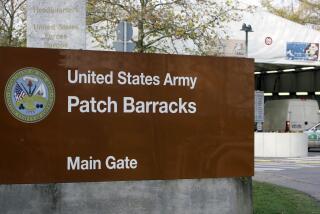U.S. Scales Down NATO War Game as European Tensions Ease
- Share via
WASHINGTON — In another reflection of easing U.S.-Soviet military tensions, the Pentagon announced Tuesday that it is sharply scaling back the annual war game in which NATO allies practice their response to a Warsaw Pact invasion in Europe.
Only two years ago, 125,000 allied soldiers took part in the “Return of Forces to Germany” (Reforger) exercise, which is designed to simulate a massive U.S. reinforcement of NATO forces in the event of a non-nuclear war in Western Europe.
Pentagon spokesman Pete Williams said the number of allied troops will be reduced to 57,500 in this year’s exercise, which begins Dec. 28 in West Germany. Of the total, 15,000 will be American soldiers. A further 12,000 support personnel will operate out of unit headquarters in West Germany.
The Army, whose $100-million request for Reforger funds was trimmed by $15 million, also has decided not to use 1,200 of its main battle tanks in the exercise, Williams said.
The reduced scale of the exercise also is designed to blunt rising discontent among West Germany’s civilian population with the noise and destruction caused by large-scale military maneuvers.
American military officials have argued that the training benefits of the war games could be replicated more cheaply and with less disruption to civilians if the allies made more use of training simulators and “command post exercises.”
“I’ve felt for a long time that we over-exercise,” Gen. John Galvin, commander of North Atlantic Treaty Organization forces, said in a recent interview. “Simulators are the wave of the future.”
At the same time, Galvin acknowledged that the growing improbability of a Warsaw Pact attack on Western Europe brought about by the changes sweeping through Eastern Europe has increased pressure to minimize the disruptions of military maneuvers.
This year’s Reforger exercise and its central military maneuver, called Centurion Shield, will bring 15,000 U.S. troops to West Germany. They will include units from the 10th Mountain Division with Light Infantry from Ft. Drum, N.Y., the 2nd Armored Division based at Ft. Hood, Tex., and the 194th Armored Brigade based at Ft. Knox, Ky. A brigade from the Alabama National Guard also will take part.
This year’s exercise was initially planned to involve 88,700 soldiers, including 17,400 U.S. troops.
The changes come as the Defense Department, responding to the waning threat of Soviet aggression, considers ways to cut costs.
The Army is preparing to cut its 222,000-person force in Western Europe by almost one-third, to about 150,000 troops.
Air Force units in Western Europe, now numbering roughly 87,000 servicemen and women, would be scaled back to about 50,000, defense officials say.
The Army would shrink its more than four divisions in Western Europe to a force of about two divisions, according to Army officials.
“If we don’t ante up a corps (roughly two divisions), we’re not in the game,” said one Army official involved in the service’s long-range planning.
Another 13 Army divisions, many of them retrained and re-equipped for rapid deployment, would be scattered throughout the United States and the Pacific under an Army blueprint for the future.
Times staff writer John M. Broder also contributed to this report.
More to Read
Sign up for Essential California
The most important California stories and recommendations in your inbox every morning.
You may occasionally receive promotional content from the Los Angeles Times.














